Report on Servant Leadership: Analysis and Real-World Examples
VerifiedAdded on 2021/01/03
|7
|2089
|340
Report
AI Summary
This report provides an in-depth analysis of servant leadership, defining its core aspects and exploring how it addresses the challenges faced by contemporary leaders. It identifies key characteristics such as moral integrity, a focus on serving followers, superior listening skills, and persuasion over coercion. The report then examines how servant leadership can be applied to overcome challenges such as starting new initiatives, dealing with endings, and navigating difficult times. A significant portion of the report is dedicated to illustrating servant leadership through the example of Mother Teresa, highlighting her dedication to serving the poor and sick, and demonstrating how her actions embody the principles of this leadership style. The report concludes by emphasizing the importance of servant leadership in fostering a more humane and effective approach to leadership, advocating for a shift from self-serving motives to a focus on the well-being of others.

Leadership Analysis
Paraphrase This Document
Need a fresh take? Get an instant paraphrase of this document with our AI Paraphraser
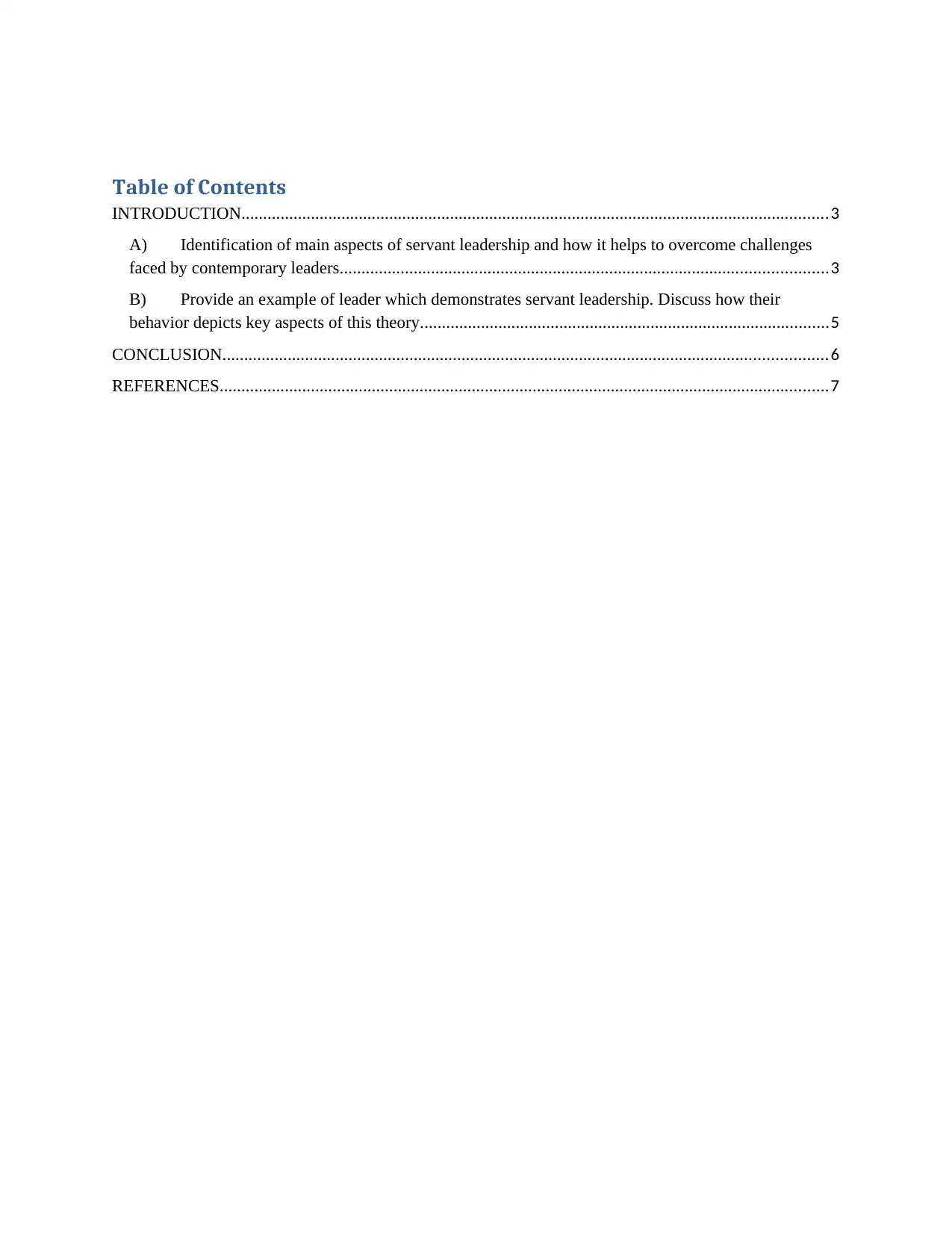
Table of Contents
INTRODUCTION.......................................................................................................................................3
A) Identification of main aspects of servant leadership and how it helps to overcome challenges
faced by contemporary leaders................................................................................................................3
B) Provide an example of leader which demonstrates servant leadership. Discuss how their
behavior depicts key aspects of this theory..............................................................................................5
CONCLUSION...........................................................................................................................................6
REFERENCES............................................................................................................................................7
INTRODUCTION.......................................................................................................................................3
A) Identification of main aspects of servant leadership and how it helps to overcome challenges
faced by contemporary leaders................................................................................................................3
B) Provide an example of leader which demonstrates servant leadership. Discuss how their
behavior depicts key aspects of this theory..............................................................................................5
CONCLUSION...........................................................................................................................................6
REFERENCES............................................................................................................................................7
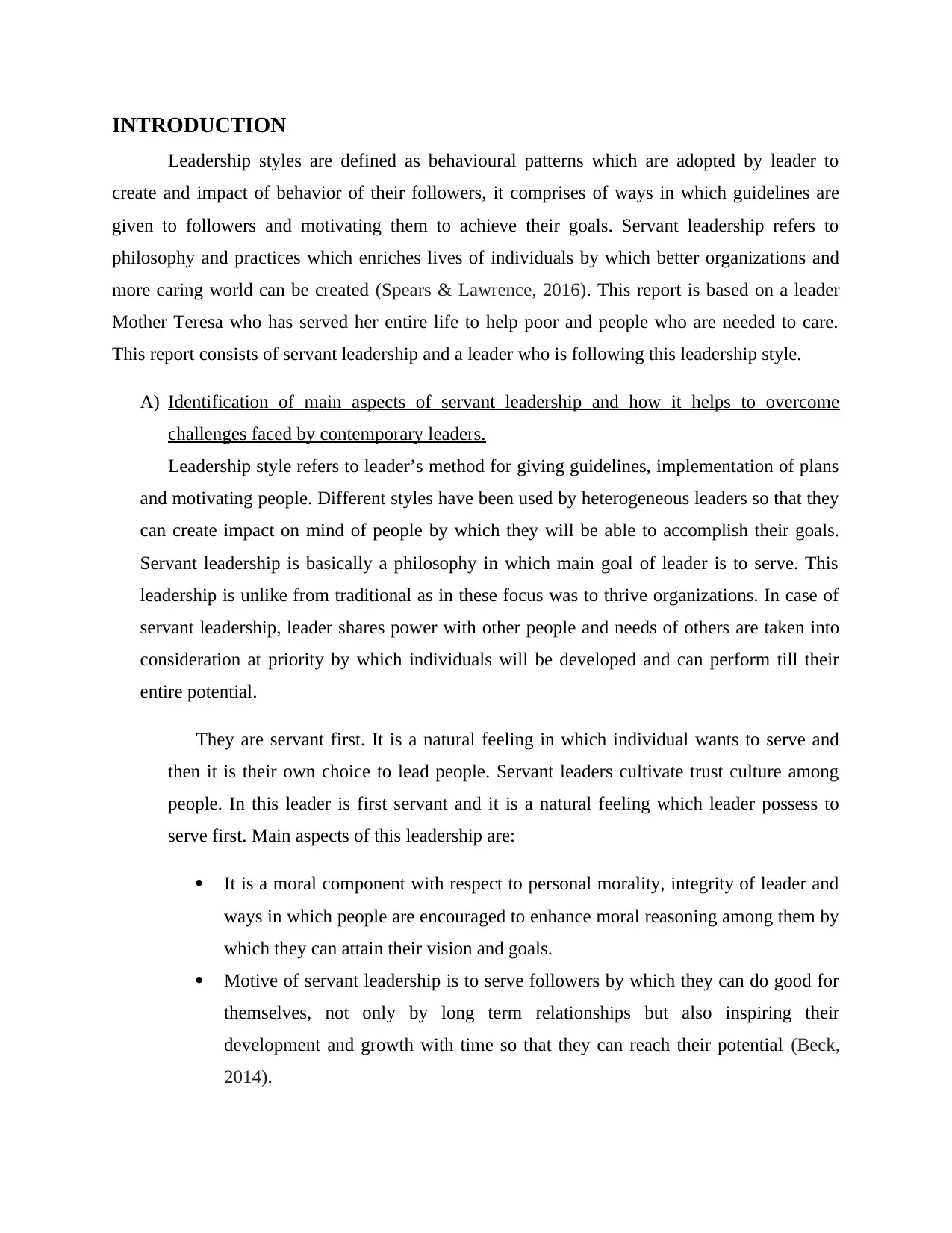
INTRODUCTION
Leadership styles are defined as behavioural patterns which are adopted by leader to
create and impact of behavior of their followers, it comprises of ways in which guidelines are
given to followers and motivating them to achieve their goals. Servant leadership refers to
philosophy and practices which enriches lives of individuals by which better organizations and
more caring world can be created (Spears & Lawrence, 2016). This report is based on a leader
Mother Teresa who has served her entire life to help poor and people who are needed to care.
This report consists of servant leadership and a leader who is following this leadership style.
A) Identification of main aspects of servant leadership and how it helps to overcome
challenges faced by contemporary leaders.
Leadership style refers to leader’s method for giving guidelines, implementation of plans
and motivating people. Different styles have been used by heterogeneous leaders so that they
can create impact on mind of people by which they will be able to accomplish their goals.
Servant leadership is basically a philosophy in which main goal of leader is to serve. This
leadership is unlike from traditional as in these focus was to thrive organizations. In case of
servant leadership, leader shares power with other people and needs of others are taken into
consideration at priority by which individuals will be developed and can perform till their
entire potential.
They are servant first. It is a natural feeling in which individual wants to serve and
then it is their own choice to lead people. Servant leaders cultivate trust culture among
people. In this leader is first servant and it is a natural feeling which leader possess to
serve first. Main aspects of this leadership are:
It is a moral component with respect to personal morality, integrity of leader and
ways in which people are encouraged to enhance moral reasoning among them by
which they can attain their vision and goals.
Motive of servant leadership is to serve followers by which they can do good for
themselves, not only by long term relationships but also inspiring their
development and growth with time so that they can reach their potential (Beck,
2014).
Leadership styles are defined as behavioural patterns which are adopted by leader to
create and impact of behavior of their followers, it comprises of ways in which guidelines are
given to followers and motivating them to achieve their goals. Servant leadership refers to
philosophy and practices which enriches lives of individuals by which better organizations and
more caring world can be created (Spears & Lawrence, 2016). This report is based on a leader
Mother Teresa who has served her entire life to help poor and people who are needed to care.
This report consists of servant leadership and a leader who is following this leadership style.
A) Identification of main aspects of servant leadership and how it helps to overcome
challenges faced by contemporary leaders.
Leadership style refers to leader’s method for giving guidelines, implementation of plans
and motivating people. Different styles have been used by heterogeneous leaders so that they
can create impact on mind of people by which they will be able to accomplish their goals.
Servant leadership is basically a philosophy in which main goal of leader is to serve. This
leadership is unlike from traditional as in these focus was to thrive organizations. In case of
servant leadership, leader shares power with other people and needs of others are taken into
consideration at priority by which individuals will be developed and can perform till their
entire potential.
They are servant first. It is a natural feeling in which individual wants to serve and
then it is their own choice to lead people. Servant leaders cultivate trust culture among
people. In this leader is first servant and it is a natural feeling which leader possess to
serve first. Main aspects of this leadership are:
It is a moral component with respect to personal morality, integrity of leader and
ways in which people are encouraged to enhance moral reasoning among them by
which they can attain their vision and goals.
Motive of servant leadership is to serve followers by which they can do good for
themselves, not only by long term relationships but also inspiring their
development and growth with time so that they can reach their potential (Beck,
2014).
⊘ This is a preview!⊘
Do you want full access?
Subscribe today to unlock all pages.

Trusted by 1+ million students worldwide
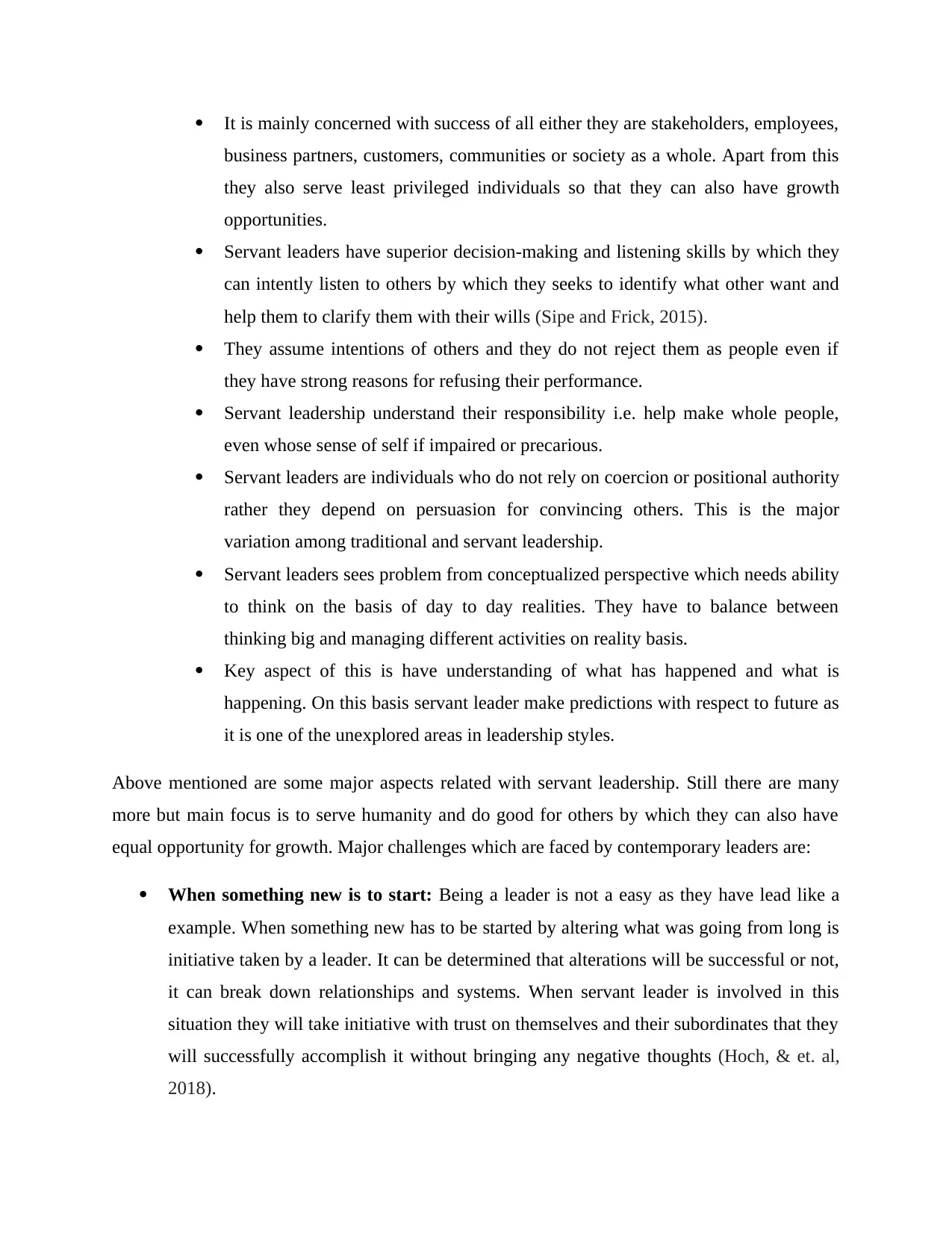
It is mainly concerned with success of all either they are stakeholders, employees,
business partners, customers, communities or society as a whole. Apart from this
they also serve least privileged individuals so that they can also have growth
opportunities.
Servant leaders have superior decision-making and listening skills by which they
can intently listen to others by which they seeks to identify what other want and
help them to clarify them with their wills (Sipe and Frick, 2015).
They assume intentions of others and they do not reject them as people even if
they have strong reasons for refusing their performance.
Servant leadership understand their responsibility i.e. help make whole people,
even whose sense of self if impaired or precarious.
Servant leaders are individuals who do not rely on coercion or positional authority
rather they depend on persuasion for convincing others. This is the major
variation among traditional and servant leadership.
Servant leaders sees problem from conceptualized perspective which needs ability
to think on the basis of day to day realities. They have to balance between
thinking big and managing different activities on reality basis.
Key aspect of this is have understanding of what has happened and what is
happening. On this basis servant leader make predictions with respect to future as
it is one of the unexplored areas in leadership styles.
Above mentioned are some major aspects related with servant leadership. Still there are many
more but main focus is to serve humanity and do good for others by which they can also have
equal opportunity for growth. Major challenges which are faced by contemporary leaders are:
When something new is to start: Being a leader is not a easy as they have lead like a
example. When something new has to be started by altering what was going from long is
initiative taken by a leader. It can be determined that alterations will be successful or not,
it can break down relationships and systems. When servant leader is involved in this
situation they will take initiative with trust on themselves and their subordinates that they
will successfully accomplish it without bringing any negative thoughts (Hoch, & et. al,
2018).
business partners, customers, communities or society as a whole. Apart from this
they also serve least privileged individuals so that they can also have growth
opportunities.
Servant leaders have superior decision-making and listening skills by which they
can intently listen to others by which they seeks to identify what other want and
help them to clarify them with their wills (Sipe and Frick, 2015).
They assume intentions of others and they do not reject them as people even if
they have strong reasons for refusing their performance.
Servant leadership understand their responsibility i.e. help make whole people,
even whose sense of self if impaired or precarious.
Servant leaders are individuals who do not rely on coercion or positional authority
rather they depend on persuasion for convincing others. This is the major
variation among traditional and servant leadership.
Servant leaders sees problem from conceptualized perspective which needs ability
to think on the basis of day to day realities. They have to balance between
thinking big and managing different activities on reality basis.
Key aspect of this is have understanding of what has happened and what is
happening. On this basis servant leader make predictions with respect to future as
it is one of the unexplored areas in leadership styles.
Above mentioned are some major aspects related with servant leadership. Still there are many
more but main focus is to serve humanity and do good for others by which they can also have
equal opportunity for growth. Major challenges which are faced by contemporary leaders are:
When something new is to start: Being a leader is not a easy as they have lead like a
example. When something new has to be started by altering what was going from long is
initiative taken by a leader. It can be determined that alterations will be successful or not,
it can break down relationships and systems. When servant leader is involved in this
situation they will take initiative with trust on themselves and their subordinates that they
will successfully accomplish it without bringing any negative thoughts (Hoch, & et. al,
2018).
Paraphrase This Document
Need a fresh take? Get an instant paraphrase of this document with our AI Paraphraser
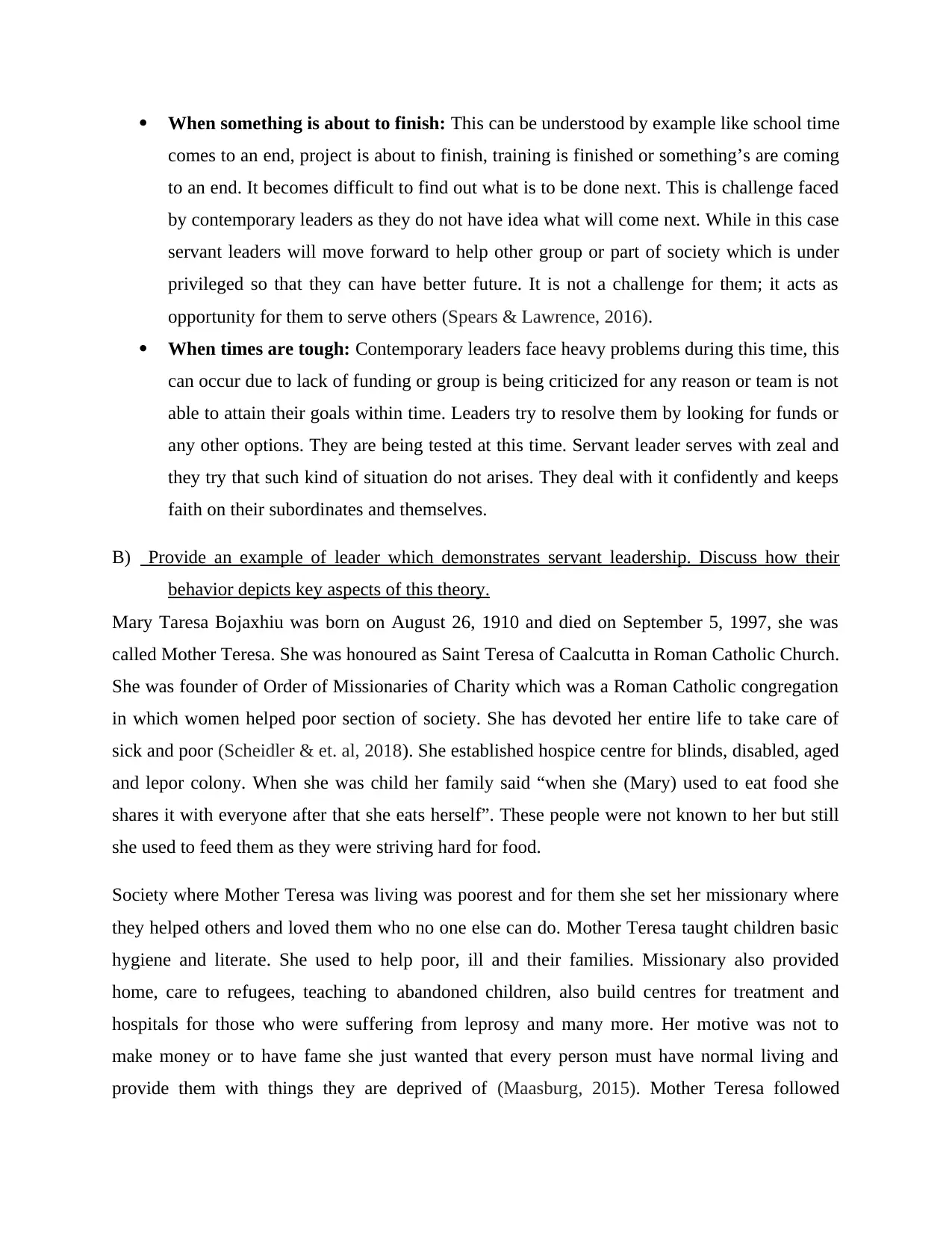
When something is about to finish: This can be understood by example like school time
comes to an end, project is about to finish, training is finished or something’s are coming
to an end. It becomes difficult to find out what is to be done next. This is challenge faced
by contemporary leaders as they do not have idea what will come next. While in this case
servant leaders will move forward to help other group or part of society which is under
privileged so that they can have better future. It is not a challenge for them; it acts as
opportunity for them to serve others (Spears & Lawrence, 2016).
When times are tough: Contemporary leaders face heavy problems during this time, this
can occur due to lack of funding or group is being criticized for any reason or team is not
able to attain their goals within time. Leaders try to resolve them by looking for funds or
any other options. They are being tested at this time. Servant leader serves with zeal and
they try that such kind of situation do not arises. They deal with it confidently and keeps
faith on their subordinates and themselves.
B) Provide an example of leader which demonstrates servant leadership. Discuss how their
behavior depicts key aspects of this theory.
Mary Taresa Bojaxhiu was born on August 26, 1910 and died on September 5, 1997, she was
called Mother Teresa. She was honoured as Saint Teresa of Caalcutta in Roman Catholic Church.
She was founder of Order of Missionaries of Charity which was a Roman Catholic congregation
in which women helped poor section of society. She has devoted her entire life to take care of
sick and poor (Scheidler & et. al, 2018). She established hospice centre for blinds, disabled, aged
and lepor colony. When she was child her family said “when she (Mary) used to eat food she
shares it with everyone after that she eats herself”. These people were not known to her but still
she used to feed them as they were striving hard for food.
Society where Mother Teresa was living was poorest and for them she set her missionary where
they helped others and loved them who no one else can do. Mother Teresa taught children basic
hygiene and literate. She used to help poor, ill and their families. Missionary also provided
home, care to refugees, teaching to abandoned children, also build centres for treatment and
hospitals for those who were suffering from leprosy and many more. Her motive was not to
make money or to have fame she just wanted that every person must have normal living and
provide them with things they are deprived of (Maasburg, 2015). Mother Teresa followed
comes to an end, project is about to finish, training is finished or something’s are coming
to an end. It becomes difficult to find out what is to be done next. This is challenge faced
by contemporary leaders as they do not have idea what will come next. While in this case
servant leaders will move forward to help other group or part of society which is under
privileged so that they can have better future. It is not a challenge for them; it acts as
opportunity for them to serve others (Spears & Lawrence, 2016).
When times are tough: Contemporary leaders face heavy problems during this time, this
can occur due to lack of funding or group is being criticized for any reason or team is not
able to attain their goals within time. Leaders try to resolve them by looking for funds or
any other options. They are being tested at this time. Servant leader serves with zeal and
they try that such kind of situation do not arises. They deal with it confidently and keeps
faith on their subordinates and themselves.
B) Provide an example of leader which demonstrates servant leadership. Discuss how their
behavior depicts key aspects of this theory.
Mary Taresa Bojaxhiu was born on August 26, 1910 and died on September 5, 1997, she was
called Mother Teresa. She was honoured as Saint Teresa of Caalcutta in Roman Catholic Church.
She was founder of Order of Missionaries of Charity which was a Roman Catholic congregation
in which women helped poor section of society. She has devoted her entire life to take care of
sick and poor (Scheidler & et. al, 2018). She established hospice centre for blinds, disabled, aged
and lepor colony. When she was child her family said “when she (Mary) used to eat food she
shares it with everyone after that she eats herself”. These people were not known to her but still
she used to feed them as they were striving hard for food.
Society where Mother Teresa was living was poorest and for them she set her missionary where
they helped others and loved them who no one else can do. Mother Teresa taught children basic
hygiene and literate. She used to help poor, ill and their families. Missionary also provided
home, care to refugees, teaching to abandoned children, also build centres for treatment and
hospitals for those who were suffering from leprosy and many more. Her motive was not to
make money or to have fame she just wanted that every person must have normal living and
provide them with things they are deprived of (Maasburg, 2015). Mother Teresa followed
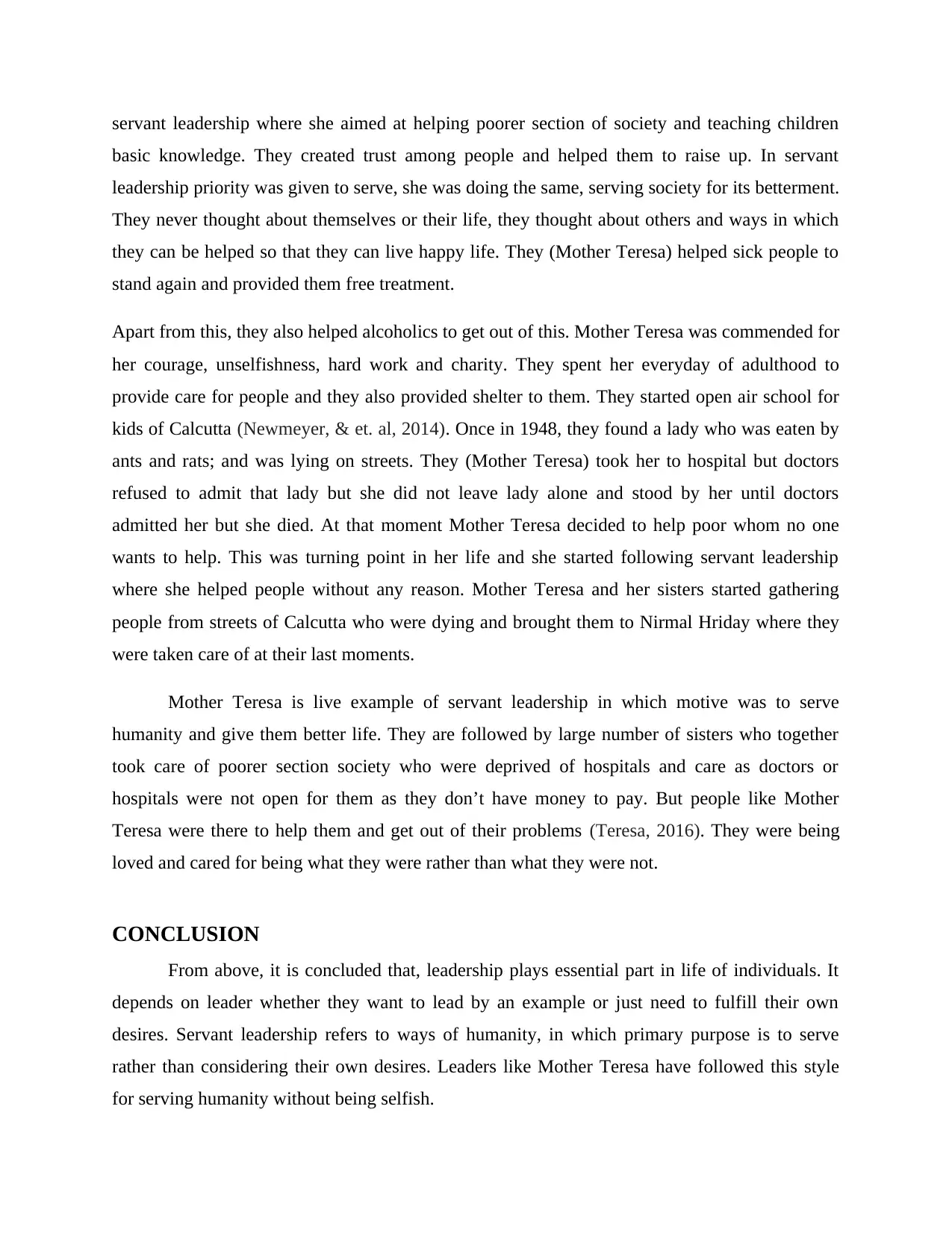
servant leadership where she aimed at helping poorer section of society and teaching children
basic knowledge. They created trust among people and helped them to raise up. In servant
leadership priority was given to serve, she was doing the same, serving society for its betterment.
They never thought about themselves or their life, they thought about others and ways in which
they can be helped so that they can live happy life. They (Mother Teresa) helped sick people to
stand again and provided them free treatment.
Apart from this, they also helped alcoholics to get out of this. Mother Teresa was commended for
her courage, unselfishness, hard work and charity. They spent her everyday of adulthood to
provide care for people and they also provided shelter to them. They started open air school for
kids of Calcutta (Newmeyer, & et. al, 2014). Once in 1948, they found a lady who was eaten by
ants and rats; and was lying on streets. They (Mother Teresa) took her to hospital but doctors
refused to admit that lady but she did not leave lady alone and stood by her until doctors
admitted her but she died. At that moment Mother Teresa decided to help poor whom no one
wants to help. This was turning point in her life and she started following servant leadership
where she helped people without any reason. Mother Teresa and her sisters started gathering
people from streets of Calcutta who were dying and brought them to Nirmal Hriday where they
were taken care of at their last moments.
Mother Teresa is live example of servant leadership in which motive was to serve
humanity and give them better life. They are followed by large number of sisters who together
took care of poorer section society who were deprived of hospitals and care as doctors or
hospitals were not open for them as they don’t have money to pay. But people like Mother
Teresa were there to help them and get out of their problems (Teresa, 2016). They were being
loved and cared for being what they were rather than what they were not.
CONCLUSION
From above, it is concluded that, leadership plays essential part in life of individuals. It
depends on leader whether they want to lead by an example or just need to fulfill their own
desires. Servant leadership refers to ways of humanity, in which primary purpose is to serve
rather than considering their own desires. Leaders like Mother Teresa have followed this style
for serving humanity without being selfish.
basic knowledge. They created trust among people and helped them to raise up. In servant
leadership priority was given to serve, she was doing the same, serving society for its betterment.
They never thought about themselves or their life, they thought about others and ways in which
they can be helped so that they can live happy life. They (Mother Teresa) helped sick people to
stand again and provided them free treatment.
Apart from this, they also helped alcoholics to get out of this. Mother Teresa was commended for
her courage, unselfishness, hard work and charity. They spent her everyday of adulthood to
provide care for people and they also provided shelter to them. They started open air school for
kids of Calcutta (Newmeyer, & et. al, 2014). Once in 1948, they found a lady who was eaten by
ants and rats; and was lying on streets. They (Mother Teresa) took her to hospital but doctors
refused to admit that lady but she did not leave lady alone and stood by her until doctors
admitted her but she died. At that moment Mother Teresa decided to help poor whom no one
wants to help. This was turning point in her life and she started following servant leadership
where she helped people without any reason. Mother Teresa and her sisters started gathering
people from streets of Calcutta who were dying and brought them to Nirmal Hriday where they
were taken care of at their last moments.
Mother Teresa is live example of servant leadership in which motive was to serve
humanity and give them better life. They are followed by large number of sisters who together
took care of poorer section society who were deprived of hospitals and care as doctors or
hospitals were not open for them as they don’t have money to pay. But people like Mother
Teresa were there to help them and get out of their problems (Teresa, 2016). They were being
loved and cared for being what they were rather than what they were not.
CONCLUSION
From above, it is concluded that, leadership plays essential part in life of individuals. It
depends on leader whether they want to lead by an example or just need to fulfill their own
desires. Servant leadership refers to ways of humanity, in which primary purpose is to serve
rather than considering their own desires. Leaders like Mother Teresa have followed this style
for serving humanity without being selfish.
⊘ This is a preview!⊘
Do you want full access?
Subscribe today to unlock all pages.

Trusted by 1+ million students worldwide
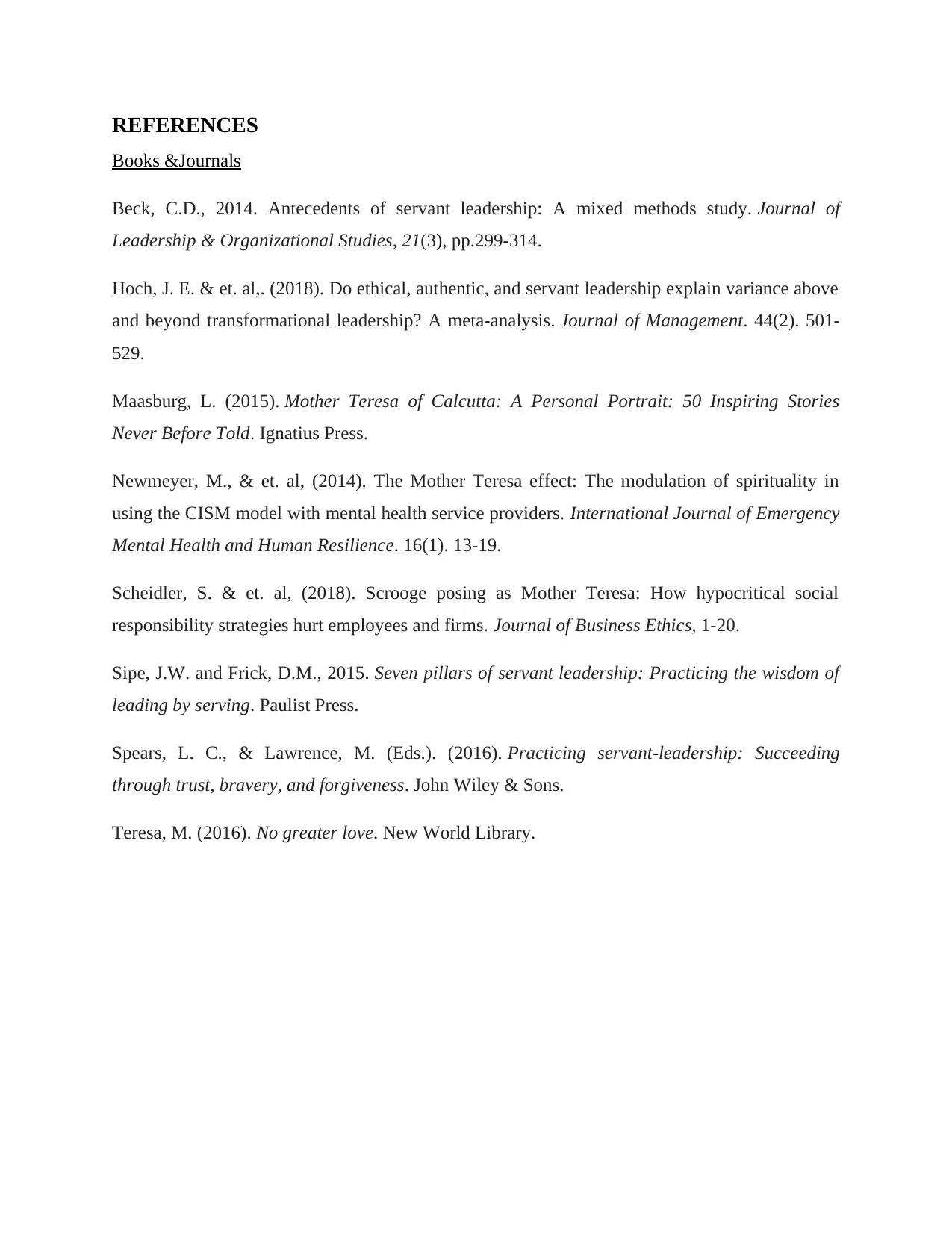
REFERENCES
Books &Journals
Beck, C.D., 2014. Antecedents of servant leadership: A mixed methods study. Journal of
Leadership & Organizational Studies, 21(3), pp.299-314.
Hoch, J. E. & et. al,. (2018). Do ethical, authentic, and servant leadership explain variance above
and beyond transformational leadership? A meta-analysis. Journal of Management. 44(2). 501-
529.
Maasburg, L. (2015). Mother Teresa of Calcutta: A Personal Portrait: 50 Inspiring Stories
Never Before Told. Ignatius Press.
Newmeyer, M., & et. al, (2014). The Mother Teresa effect: The modulation of spirituality in
using the CISM model with mental health service providers. International Journal of Emergency
Mental Health and Human Resilience. 16(1). 13-19.
Scheidler, S. & et. al, (2018). Scrooge posing as Mother Teresa: How hypocritical social
responsibility strategies hurt employees and firms. Journal of Business Ethics, 1-20.
Sipe, J.W. and Frick, D.M., 2015. Seven pillars of servant leadership: Practicing the wisdom of
leading by serving. Paulist Press.
Spears, L. C., & Lawrence, M. (Eds.). (2016). Practicing servant-leadership: Succeeding
through trust, bravery, and forgiveness. John Wiley & Sons.
Teresa, M. (2016). No greater love. New World Library.
Books &Journals
Beck, C.D., 2014. Antecedents of servant leadership: A mixed methods study. Journal of
Leadership & Organizational Studies, 21(3), pp.299-314.
Hoch, J. E. & et. al,. (2018). Do ethical, authentic, and servant leadership explain variance above
and beyond transformational leadership? A meta-analysis. Journal of Management. 44(2). 501-
529.
Maasburg, L. (2015). Mother Teresa of Calcutta: A Personal Portrait: 50 Inspiring Stories
Never Before Told. Ignatius Press.
Newmeyer, M., & et. al, (2014). The Mother Teresa effect: The modulation of spirituality in
using the CISM model with mental health service providers. International Journal of Emergency
Mental Health and Human Resilience. 16(1). 13-19.
Scheidler, S. & et. al, (2018). Scrooge posing as Mother Teresa: How hypocritical social
responsibility strategies hurt employees and firms. Journal of Business Ethics, 1-20.
Sipe, J.W. and Frick, D.M., 2015. Seven pillars of servant leadership: Practicing the wisdom of
leading by serving. Paulist Press.
Spears, L. C., & Lawrence, M. (Eds.). (2016). Practicing servant-leadership: Succeeding
through trust, bravery, and forgiveness. John Wiley & Sons.
Teresa, M. (2016). No greater love. New World Library.
1 out of 7
Related Documents
Your All-in-One AI-Powered Toolkit for Academic Success.
+13062052269
info@desklib.com
Available 24*7 on WhatsApp / Email
![[object Object]](/_next/static/media/star-bottom.7253800d.svg)
Unlock your academic potential
Copyright © 2020–2025 A2Z Services. All Rights Reserved. Developed and managed by ZUCOL.




